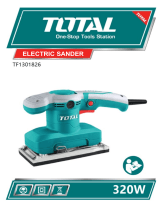
2
Security instructions
Caution
Read all safety warnings and all instructions. Failure to follow the warnings and
instructions may result in electric shock, fire, and/or serious injury.
Note: Save all warnings and instructions for future reference. Due to the continuous R+D+I
development of the brand, this manual and the technical specifications may undergo changes
without prior notice.
1) Work area safety
a. Keep the work area clean and well lit to prevent accidents.
b. Do not use power tools in explosive atmospheres, such as in the presence
of flammable liquids, gases, or dust that can cause fires.
c. Keep children and other unauthorized persons away while using a battery
tool. Distractions can cause you to lose control of the tool.
2) Electrical safety
a. Charger plugs must match the outlet. Never modify the plug in any way.
Using a suitable plug reduces the risk of electric shock.
b. Avoid bodily contact with grounded surfaces such as pipes, radiators,
ranges, and refrigerators. There is an increased risk of electric shock if
your body is grounded.
c. Do not expose tools to rain or wet conditions. Water entering a battery-
powered tool will increase the risk of electric shock.
d. Never use the cord to carry, pull, or unplug the charger from the tool. Keep
the cable away from heat or oil.
e. If using the tool in a damp location is unavoidable, use a Residual Current
Device (RCD) protected supply to reduce the risk of electric shock.
f. Make sure the mains voltage is the same as the voltage on the tool's
nameplate. Remove plug from outlet before making any adjustments or
servicing.
3) Personal security
a. Always stay alert, watch what you are doing and use common sense
when using the tool.
b. Do not use a battery tool if you are tired or under the influence of
medication or other substances.
c. Wear personal protective equipment. Always wear eye protection.
Protective equipment such as a dust mask, non-slip safety shoes, hard
hat, or hearing protection used in the proper conditions will reduce
personal injury. Also don't wear loose clothing or jewelry.
d. Prevent the tool from turning on unintentionally. Make sure the switch is
in the off position before connecting to power source and moving.
e. Remove any adjusting wrenches or wrenches before turning on the
battery tool. An adjustable wrench or wrench placed in a rotating part of
the battery tool can cause serious injury.
f. If devices are used for dust extraction and collection, make sure they are
properly connected. Properly use these devices and you will reduce dust-












